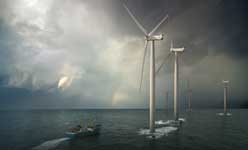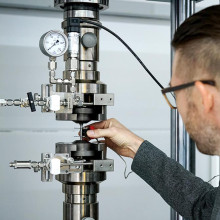Material testing and simulation for offshore wind turbines
- Details
- Hits: 5968
Freudenberg Sealing Technologies (FST) has a procedure for Materials testing and developed a simulation method for elastomer materials with which the performance and service life of components in offshore Wind Turbines let improve. The material simulation analyzes how the materials behave over the lifetime of a turbine.

With the procedure for material testing and Simulation the best available materials and designs to protect the turbine foundations from moisture and wear have already been determined.
According to forecasts, offshore wind turbines will have a total installed capacity of 1000 GW. Until 2050 the wind energy should cover 35% of the total world energy demand. There are always new challenges for operators and manufacturers because more and more turbines are being put into operation.
Offshore locations move away from the coast
"Two dominant trends in the industry are the increasing size of offshore wind turbines and their locations further from the coast," says Marcel Schreiner, Global Segment Director, Energy, Freudenberg Sealing Technologies. “Engineers are therefore forced to design offshore systems that can withstand harsh environmental conditions, remain structurally stable and at a minimum maintenance function reliably over the entire service life. Freudenberg has focused its know-how on meeting these expectations and requirements with its materials. "
 Couplings, brakes and monitoring for the wind turbine
Couplings, brakes and monitoring for the wind turbine
The service life of an average wind turbine is more than 26 years. This can lead to standard materials and components being stressed beyond their performance limits. For example, in the monopile construction, the Monopile transition piece (MP / TP) Flange gasket and high voltage cable inlet have properties that will withstand moisture and will not corrode for nearly three decades.
Material testing for turbine components
To improve the performance of seals and components in turbines To be able to predict it requires continuous research, development and testing. The Freudenberg Sealing Technology experts have developed the new test method for material testing for this purpose.
The test method can be used to assess exactly how long a material can survive in aggressive offshore wind power environments and how its properties behave. By testing the relaxation rates of a material at different temperatures, the information obtained can be converted into a mathematical curve. This is used for the Arrhenius extrapolation.
 Molded release film prevents galvanic corrosion in the car
Molded release film prevents galvanic corrosion in the car
This can reduce the aging of Elastomer material simulate to determine the life of seals. By comparing new profiles with those that have aged 26 years under the harsh conditions of offshore wind turbines, Freudenberg was able to develop, among other things, more robust solutions for the MP / TP flange seal and the seals at the inlet of the high-voltage cables.
Materials for the wind turbine
Under the label Ventoguard FTS provides a family of unique materials that improve the durability and performance of wind turbine components. The portfolio includes materials for a wide range of offshore wind power applications.
The seals are made of nitrile butadiene rubber (NBR). The synthetic one High-performance rubber has a high resistance to fat, oil and hydrocarbons. In addition, it is insensitive to temperature fluctuations, water, salt, ozone and mortar. On top of that there are advantageous aging behavior and low abrasion.
 O-ring design online for material, size and application
O-ring design online for material, size and application
In combination with a well thought-out single or double seal, the Ventoguard materials perform better than commercial alternatives. The resulting seals are very robust, prevent salt water from entering and thus prevent foundation damage.
Other components for Freudenberg's wind turbines, such as globally certified seals and pressure accumulators, reduce preload losses and absorb pressures of up to 350 bar or 5000 psi. They thus contribute to the reliable operation of the gigantic energy systems.
You might also be interested in...

Reduce carbon footprint | That's how it's done!

